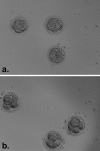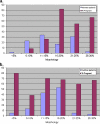Intracytoplasmic injection of morphologically selected spermatozoa (IMSI) improves outcome after assisted reproduction by deselecting physiologically poor quality spermatozoa
- PMID: 21072684
- PMCID: PMC3082654
- DOI: 10.1007/s10815-010-9505-5
Intracytoplasmic injection of morphologically selected spermatozoa (IMSI) improves outcome after assisted reproduction by deselecting physiologically poor quality spermatozoa
Abstract
Purpose: We used computer assisted sperm selection (MSOME) during cycles of intracytoplasmic sperm injection to test whether this technique improves results over traditional ICSI protocols. We also used the TUNEL assay to test whether MSOME could deselect physiologically abnormal spermatozoa.
Methods: Individual spermatozoa were examined with MSOME. Normal and abnormal spermatozoa were tested for the level of DNA fragmentation using TUNEL assay. In a prospective, randomized trial, patients were selected for standard ICSI, or IMSI techniques. We tested the two groups for biological and clinical parameters.
Results: 64.8% of spermatozoa, otherwise selectable for ICSI, were characterized by abnormalities after computer-assisted sperm analysis. These sperm were also characterized by an increase in the level of DNA fragmentation. We noted an increase in embryo quality, pregnancy and implantation rates after computerized sperm selection during ICSI procedures.
Conclusions: Computerised selection of spermatozoa during ICSI procedures deselects physiological abnormal spermatozoa and improves clinical results.
Figures





Similar articles
-
Pregnancy outcomes in women with repeated implantation failures after intracytoplasmic morphologically selected sperm injection (IMSI).Reprod Biol Endocrinol. 2011 Jul 22;9:99. doi: 10.1186/1477-7827-9-99. Reprod Biol Endocrinol. 2011. PMID: 21781299 Free PMC article.
-
Is intracytoplasmic morphologically selected sperm injection (IMSI) beneficial in the first ART cycle? a multicentric randomized controlled trial.Andrology. 2013 Sep;1(5):692-7. doi: 10.1111/j.2047-2927.2013.00104.x. Epub 2013 Jun 21. Andrology. 2013. PMID: 23788532 Clinical Trial.
-
[Intracytoplasmic morphologically selected sperm injection (IMSI) vs intracytoplasmic sperm injection (ICSI) in patients with repeated ICSI failure].Ginecol Obstet Mex. 2010 Dec;78(12):652-9. Ginecol Obstet Mex. 2010. PMID: 21961371 Clinical Trial. Spanish.
-
Focus on intracytoplasmic morphologically selected sperm injection (IMSI): a mini-review.Asian J Androl. 2013 Sep;15(5):608-15. doi: 10.1038/aja.2013.54. Epub 2013 Jul 8. Asian J Androl. 2013. PMID: 23832017 Free PMC article. Review.
-
Twelve years of MSOME and IMSI: a review.Reprod Biomed Online. 2013 Oct;27(4):338-52. doi: 10.1016/j.rbmo.2013.06.011. Epub 2013 Jun 28. Reprod Biomed Online. 2013. PMID: 23948449 Review.
Cited by
-
The influence of leukocytospermia on the outcomes of assisted reproductive technology.Reprod Biol Endocrinol. 2012 Jun 15;10:44. doi: 10.1186/1477-7827-10-44. Reprod Biol Endocrinol. 2012. PMID: 22703930 Free PMC article.
-
Novel Techniques of Sperm Selection for Improving IVF and ICSI Outcomes.Front Cell Dev Biol. 2019 Nov 29;7:298. doi: 10.3389/fcell.2019.00298. eCollection 2019. Front Cell Dev Biol. 2019. PMID: 31850340 Free PMC article. Review.
-
Pregnancy outcomes in women with repeated implantation failures after intracytoplasmic morphologically selected sperm injection (IMSI).Reprod Biol Endocrinol. 2011 Jul 22;9:99. doi: 10.1186/1477-7827-9-99. Reprod Biol Endocrinol. 2011. PMID: 21781299 Free PMC article.
-
Impact of high magnification sperm selection on neonatal outcomes: a retrospective study.J Assist Reprod Genet. 2018 Jun;35(6):1113-1121. doi: 10.1007/s10815-018-1167-8. Epub 2018 Apr 2. J Assist Reprod Genet. 2018. PMID: 29607458 Free PMC article.
-
Oxidative stress and male infertility.Reprod Med Biol. 2020 Oct 18;20(1):41-52. doi: 10.1002/rmb2.12353. eCollection 2021 Jan. Reprod Med Biol. 2020. PMID: 33488282 Free PMC article. Review.
References
-
- Palermo GD, Cohen J, Alikani M, Adler A, Rosenwaks Z. Intracytoplasmic sperm injection: a novel treatment for all forms of male factor infertility. Fertil Steril. 1995;63:1231–40. - PubMed
-
- Sherins RJ, Thorsell LP, Dorfmann A, Dennison-Lagos L, Calvo LP, Krysa L, Coulam CB, Schulman JD. Intracytoplasmic sperm injection facilitates fertilization even in the most severe forms of male infertility: pregnancy outcome correlates with maternal age and number of eggs available. Fertil Steril. 1995;64:369–75. - PubMed
Publication types
MeSH terms
LinkOut - more resources
Full Text Sources
Medical

